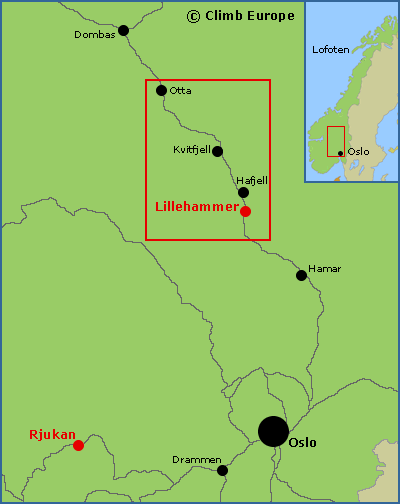Ice Climbing in Norway
Norway has many great mountains and numerous frozen waterfalls that dot the landscape providing plenty of ice climbing locations. Some classic areas include Romsdal, Lofoten Islands, Setesdal, and Narvik. However, it is the easily accessible and reliable ice found at Rjukan and around Lillehammer that draw climbers from all over the World for a great ice climbing holiday.
Ice Climbing at Rjukan
Map of the ice climbing locations of Rjukan and Lillehammer

Ice Climbing around Lillehammer
The valley of Gudbrandsdalen is one of Norway’s most popular destinations for winter sports, particularly around the famous ski resorts of Lillehammer, Hafjell, and Kvitfjell. Thanks to its inland location in the centre of the Scandinavian peninsula, Gudbrandsdalen enjoys cold winters, with plentiful snow and reliable ice, making it a dream destination for skiers and ice climbers alike.
The ice climbing is spread out along the Gudbrandsdalen valley between Lillehammer and Otta, offering a superb variety of routes with plenty to offer, particularly in the lower to middle grades. The ice climbing here has remained something of a well-kept secret in climbing circles, so you’ll find peace and tranquillity. Icefalls are tucked away in the trees, spectacular gorges and magnificent open spaces, all free from the crowds that typically descend on Europe’s better known ice climbing destinations during the winter months.
Lillehammer’s inland location means that it enjoys long, cold winters, often with fairly settled weather. The ice climbing season generally starts around December to late March, with January and February historically seeing the best ice conditions.
The Lillehammer Selected Ice Climbs guidebook describes 275 of the best ice climbs along the Gudbrandsdalen Valley between Lillehammer and Otta. It describes a good mix of long multi-pitch classics as well as roadside ice crags and top-roping venues. The routes in this area are ideal for low to mid-grade climbers, with many routes in the WI3 to WI4 grade range. Buy the Lillehammer Selected Ice Climbs Guidebook from our shop.
Lillehammer is located 180km to the north of Oslo. So, getting to Lillehammer is easy, just fly to Oslo, and then it is roughly a 2-hour drive to Lillehammer. As a place to combine a skiing and ice climbing holiday, it’s a destination that is hard to beat.
